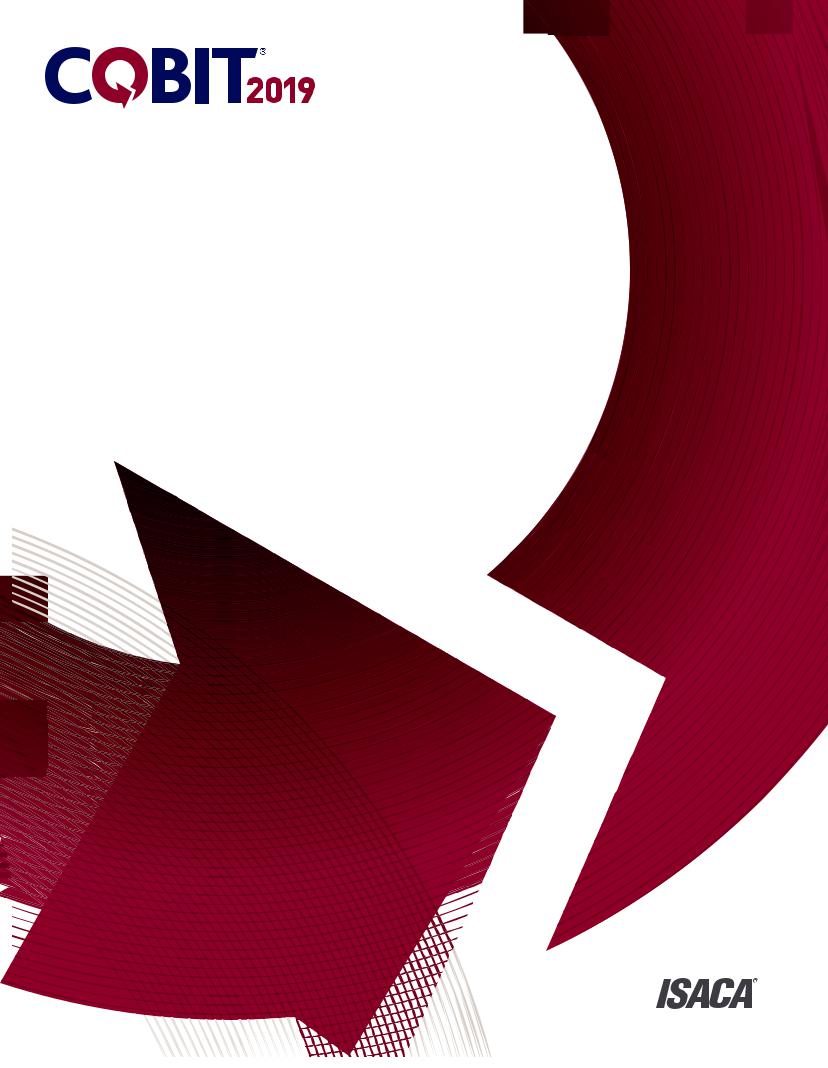
- •1.1 COBIT as an Information and Technology Governance Framework
- •1.1.1 What Is COBIT and What Is It Not?
- •1.2 Overview of COBIT® 2019
- •1.3 Terminology and Key Concepts of the COBIT Framework
- •1.3.1 Governance and Management Objectives
- •1.3.2 Components of the Governance System
- •1.3.3 Focus Areas
- •Chapter 2 Structure of This Publication and Intended Audience
- •2.1 Structure of This Publication
- •2.2 Intended Audience
- •Chapter 3 Structure of COBIT Governance and Management Objectives
- •3.1 Introduction
- •3.2 Governance and Management Objectives
- •3.3 Goals Cascade
- •3.4 Component: Process
- •3.5 Component: Organizational Structures
- •3.6 Component: Information Flows and Items
- •3.8 Component: Policies and Procedures
- •3.9 Component: Culture, Ethics and Behavior
- •3.10 Component: Services, Infrastructure and Applications
- •Chapter 4 COBIT Governance and Management Objectives—Detailed Guidance
- •COBIT Core Model
- •4.1 Evaluate, Direct and Monitor (EDM)
- •4.2 Align, Plan and Organize (APO)
- •4.3 Build, Acquire and Implement (BAI)
- •4.4 Deliver, Service and Support (DSS)
- •4.5 Monitor, Evaluate and Assess (MEA)
- •Appendices
- •5.1 Appendix A: Goals Cascade—Mapping Tables
- •5.1.1 Mapping Table: Enterprise Goals—Alignment Goals
- •5.1.2 Mapping Table: Alignment Goals—Governance and Management Objectives
- •5.2 Appendix B: Organizational Structures—Overview and Descriptions
- •5.3 Appendix C: Detailed List of References

FRAMEWORK
Governance and
Management Objectives

COBIT® 2019 FRAMEWORK: GOVERNANCE AND MANAGEMENT OBJECTIVES
About ISACA
Nearing its 50th year, ISACA® (isaca.org) is a global association helping individuals and enterprises achieve the positive potential of technology. Technology powers today’s world and ISACA equips professionals with the knowledge, credentials, education and community to advance their careers and transform their organizations. ISACA leverages the expertise of its half-million engaged professionals in information and cyber security, governance, assurance, risk and innovation, as well as its enterprise performance subsidiary, CMMI® Institute, to help advance innovation through technology. ISACA has a presence in more than 188 countries, including more than 217 chapters and offices in both the United States and China.
Disclaimer
ISACA has designed and created COBIT® 2019 Framework: Governance and Management Objectives (the “Work”) primarily as an educational resource for governance of enterprise IT (GEIT), assurance, risk and security professionals. ISACA
makes no claim that use of any of the Work will assure a successful outcome. The Work should not be considered inclusive of all proper information, procedures and tests or exclusive of other information, procedures and tests that are reasonably directed to obtaining the same results. In determining the propriety of any specific information, procedure or test, governance of enterprise IT (GEIT), assurance, risk and security professionals should apply their own professional judgment to the specific circumstances presented by the particular systems or information
technology environment.
Copyright
© 2018 ISACA. All rights reserved. For usage guidelines, see www.isaca.org/COBITuse.
ISACA
1700 E. Golf Road, Suite 400 Schaumburg, IL 60173, USA Phone: +1.847.660.5505 Fax: +1.847.253.1755
Contact us: https://support.isaca.org Website: www.isaca.org
Participate in the ISACA Online Forums: https://engage.isaca.org/onlineforums
Twitter: http://twitter.com/ISACANews
LinkedIn: http://linkd.in/ISACAOfficial
Facebook: www.facebook.com/ISACAHQ
Instagram: www.instagram.com/isacanews/
COBIT® 2019 Framework: Governance and Management Objectives
ISBN 978-1-60420-764-4
2

IN MEMORIAM: JOHN LAINHART (1946-2018)
In Memoriam: John Lainhart (1946-2018)
Dedicated to John Lainhart, ISACA Board chair 1984-1985. John was instrumental in the creation of the COBIT® framework and most recently served as chair of the working group for COBIT® 2019, which culminated in the creation of this work. Over his four decades with ISACA, John was involved in numerous aspects of the association as well as holding ISACA’s CISA, CRISC, CISM and CGEIT certifications. John leaves behind a remarkable personal and professional legacy, and his efforts significantly impacted ISACA.
3

COBIT® 2019 FRAMEWORK: GOVERNANCE AND MANAGEMENT OBJECTIVES
Page intentionally left blank
4

ACKNOWLEDGMENTS
Acknowledgments
ISACA wishes to recognize:
COBIT Working Group (2017-2018)
John Lainhart, Chair, CISA, CRISC, CISM, CGEIT, CIPP/G, CIPP/US, Grant Thornton, USA Matt Conboy, Cigna, USA
Ron Saull, CGEIT, CSP, Great-West Lifeco & IGM Financial (retired), Canada
Development Team
Steven De Haes, Ph.D., Antwerp Management School, University of Antwerp, Belgium
Matthias Goorden, PwC, Belgium
Stefanie Grijp, PwC, Belgium
Geert Poels, PhD, Ghent University, Belgium
Dirk Steuperaert, CISA, CRISC, CGEIT, IT In Balance, Belgium
Expert Reviewers
Sarah Ahmad Abedin, CISA, CRISC, CGEIT, Grant Thornton LLP, USA
Floris Ampe, CISA, CRISC, CGEIT, CIA, ISO27000, PRINCE2, TOGAF, PwC, Belgium Elisabeth Antonssen, Nordea Bank, Sweden
Krzystof Baczkiewicz, CHAMP, CITAM, CSAM, Transpectit, Poland
Christopher M. Ballister, CRISC, CISM, CGEIT, Grant Thornton, USA Gary Bannister, CGEIT, CGMA, FCMA, Austria
Graciela Braga, CGEIT, Auditor and Advisor, Argentina Ricardo Bria, CISA, CRISC, CGEIT, COTO CICSA, Argentina Sushil Chatterji, CGEIT, Edutech Enterprises, Singapore
Peter T. Davis, CISA, CISM, CGEIT, COBIT 5 Assessor, CISSP, CMA, CPA, PMI-RMP, PMP, Peter Davis+Associates, Canada James Doss, CISM, CGEIT, EMCCA, ITIL Expert, PMP, SSGB, TOGAF 9, ITvalueQuickStart.com, USA
Yalcin Gerek, CISA, CRISC, CGEIT, ITIL Expert, Prince2, ISO 20000LI, ISO27001LA, TAC AS., Turkey James L. Golden, Golden Consulting Associates, USA
J. Winston Hayden, CISA, CISM, CRISC, CGEIT, South Africa Jimmy Heschl, CISA, CISM, CGEIT, Red Bull, Austria
Jorge Hidalgo, CISA, CISM, CGEIT, Chile
John Jasinski, CISA, CRISC, CISM, CGEIT, COBIT 5 Assessor, CSM, CSPO, IT4IT-F, ITIL Expert, Lean IT-F, MOF, SSBB, TOGAF-F, USA
Joanna Karczewska, CISA, Poland
Glenn Keaveny, CEH, CISSP, Grant Thornton, USA
Eddy Khoo S. K., CGEIT, Kuala Lumpur, Malaysia
Joao Souza Neto, CRISC, CGEIT, Universidade Católica de Brasília, Brazil Tracey O’Brien, CISA, CISM, CGEIT, IBM Corp (retired), USA
Zachy Olorunojowon, CISA, CGEIT, PMP, BC Ministry of Health, Victoria, BC Canada
Opeyemi Onifade, CISA, CISM, CGEIT, BRMP, CISSP, ISO 27001LA, M.IoD, Afenoid Enterprise Limited, Nigeria Abdul Rafeq, CISA, CGEIT, FCA, Managing Director, Wincer Infotech Limited, India
Dirk Reimers, Entco Deutschland GmbH, A Micro Focus Company Steve Reznik, CISA, CRISC, ADP, LLC., USA
Bruno Horta Soares, CISA, CRISC, CGEIT, PMP, GOVaaS - Governance Advisors, as-a-Service, Portugal
Dr. Katalin Szenes, Ph.D., CISA, CISM, CGEIT, CISSP, John von Neumann Faculty of Informatics, Obuda University, Hungary Mark Thomas, CRISC, CGEIT, Escoute, USA
John Thorp, CMC, ISP, ITCP, The Thorp Network, Canada Greet Volders, CGEIT, COBIT Assessor, Voquals N.V., Belgium
5

COBIT® 2019 FRAMEWORK: GOVERNANCE AND MANAGEMENT OBJECTIVES
Acknowledgments (cont.)
Expert Reviewers (cont.)
Markus Walter, CISA, CISM, CISSP, ITIL, PMP, TOGAF, PwC Singapore/Switzerland
David M. Williams, CISA, CAMS, Westpac, New Zealand
Greg Witte, CISM, G2 Inc., USA
ISACA Board of Directors
Rob Clyde, Chair, CISM, Clyde Consulting LLC, USA
Brennan Baybeck, Vice-Chair, CISA, CRISC, CISM, CISSP, Oracle Corporation, USA Tracey Dedrick, Former Chief Risk Officer with Hudson City Bancorp, USA
Leonard Ong, CISA, CRISC, CISM, CGEIT, COBIT 5 Implementer and Assessor, CFE, CIPM, CIPT, CISSP, CITBCM, CPP, CSSLP, GCFA, GCIA, GCIH, GSNA, ISSMP-ISSAP, PMP, Merck & Co., Inc., Singapore
R.V. Raghu, CISA, CRISC, Versatilist Consulting India Pvt. Ltd., India
Gabriela Reynaga, CISA, CRISC, COBIT 5 Foundation, GRCP, Holistics GRC, Mexico Gregory Touhill, CISM, CISSP, Cyxtera Federal Group, USA
Ted Wolff, CISA, Vanguard, Inc., USA
Tichaona Zororo, CISA, CRISC, CISM, CGEIT, COBIT 5 Assessor, CIA, CRMA, EGIT, Enterprise Governance of IT, South Africa
Theresa Grafenstine, CISA, CRISC, CGEIT, CGAP, CGMA, CIA, CISSP, CPA, Deloitte & Touche LLP, USA, ISACA Board Chair, 2017-2018
Chris K. Dimitriadis, Ph.D., CISA, CRISC, CISM, INTRALOT, Greece, ISACA Board Chair, 2015-2017 Matt Loeb, CGEIT, CAE, FASAE, Chief Executive Officer, ISACA, USA
Robert E Stroud (1965-2018), CRISC, CGEIT, XebiaLabs, Inc., USA, ISACA Board Chair, 2014-2015
ISACA is deeply saddened by the passing of Robert E Stroud in September 2018.
6

|
TABLE OF CONTENTS |
|
TABLE OF CONTENTS |
|
|
Chapter 1. Introduction to COBIT® 2019................................................................................................................. |
9 |
|
1.1 |
COBIT as an Information and Technology Governance Framework .................................................................................................. |
9 |
|
1.1.1 What Is COBIT and What Is It Not? .......................................................................................................................................... |
9 |
1.2 |
Overview of COBIT® 2019................................................................................................................................................................ |
10 |
1.3 Terminology and Key Concepts of the COBIT Framework .............................................................................................................. |
11 |
|
|
1.3.1 Governance and Management Objectives ................................................................................................................................ |
11 |
|
1.3.2 Components of the Governance System................................................................................................................................... |
12 |
|
1.3.3 Focus Areas............................................................................................................................................................................... |
14 |
Chapter 2. Structure of This Publication and Intended Audience .......................................... |
15 |
|
2.1 |
Structure of This Publication ............................................................................................................................................................. |
15 |
2.2 |
Intended Audience ............................................................................................................................................................................. |
15 |
Chapter 3. Structure of COBIT Governance and Management Objectives................. |
17 |
|
3.1 |
Introduction........................................................................................................................................................................................ |
17 |
3.2 |
Governance and Management Objectives.......................................................................................................................................... |
17 |
3.3 |
Goals Cascade.................................................................................................................................................................................... |
18 |
3.4 |
Component: Process........................................................................................................................................................................... |
19 |
3.5 |
Component: Organizational Structures.............................................................................................................................................. |
20 |
3.6 |
Component: Information Flows and Items ........................................................................................................................................ |
22 |
3.7 |
Component: People, Skills and Competencies .................................................................................................................................. |
24 |
3.8 |
Component: Policies and Procedures................................................................................................................................................. |
25 |
3.9 |
Component: Culture, Ethics and Behavior ........................................................................................................................................ |
25 |
3.10 Component: Services, Infrastructure and Applications ................................................................................................................... |
25 |
|
Chapter 4. COBIT Governance and Management Objectives – |
|
|
|
Detailed Guidance ........................................................................................................................................... |
27 |
COBIT Core Model ................................................................................................................................................................................. |
27 |
|
|
4.1 Evaluate, Direct and Monitor (EDM).......................................................................................................................................... |
27 |
|
4.2 Align, Plan and Organize (APO) ................................................................................................................................................. |
53 |
|
4.3 Build, Acquire and Implement (BAI) ........................................................................................................................................ |
151 |
|
4.4 Deliver, Service and Support (DSS) .......................................................................................................................................... |
229 |
|
4.5 Monitor, Evaluate and Assess (MEA) ....................................................................................................................................... |
271 |
Appendices............................................................................................................................................................................................ |
297 |
|
5.1 Appendix A: Goals Cascade—Mapping Tables............................................................................................................................... |
297 |
|
5.2 Appendix B: Organizational Structures—Overview and Descriptions............................................................................................ |
299 |
|
5.3 Appendix C: Detailed List of References ........................................................................................................................................ |
300 |
|
7

COBIT® 2019 FRAMEWORK: GOVERNANCE AND MANAGEMENT OBJECTIVES
LIST OF FIGURES |
|
Chapter 1. Introduction to COBIT® 2019 |
|
Figure 1.1—COBIT Overview ...................................................................................................................................................................... |
10 |
Figure 1.2—COBIT Core Model................................................................................................................................................................... |
12 |
Figure 1.3—COBIT Components of a Governance System.......................................................................................................................... |
13 |
Chapter 3. Structure of COBIT Governance and Management Objectives |
|
Figure 3.1—Display of Governance and Management Objectives................................................................................................................ |
18 |
Figure 3.2—Display of Applicable Enterprise and Alignment Goals............................................................................................................ |
18 |
Figure 3.3—Display of Applicable Goals and Example Metrics .................................................................................................................. |
19 |
Figure 3.4—Display of Process Component ................................................................................................................................................. |
19 |
Figure 3.5—Capability Levels for Processes................................................................................................................................................. |
20 |
Figure 3.6—Display of Organizational Structures Component..................................................................................................................... |
21 |
Figure 3.7—Display of Information Flows and Items Component ............................................................................................................... |
23 |
Figure 3.8—Outputs to Multiple Processes................................................................................................................................................... |
23 |
Figure 3.9—Display of People, Skills and Competencies Component ......................................................................................................... |
24 |
Figure 3.10—Display of Policies and Procedures Component ..................................................................................................................... |
25 |
Figure 3.11—Display of Culture, Ethics and Behavior Component ............................................................................................................. |
25 |
Figure 3.12—Display of Services, Infrastructure and Applications Component .......................................................................................... |
25 |
Appendices |
|
Figure 5.1—Mapping Enterprise Goals and Alignment Goals.................................................................................................................... |
297 |
Figure 5.2—Mapping Governance and Management Objectives to Alignment Goals................................................................................ |
298 |
Figure 5.3—COBIT Roles and Organizational Structures .......................................................................................................................... |
299 |
8

CHAPTER 1
INTRODUCTION TO COBIT 2019
Chapter 1
Introduction to COBIT® 2019
1.1 COBIT as an Information and Technology Governance Framework
Over the years, best-practice frameworks have been developed and promoted to assist in the process of understanding, designing and implementing enterprise governance of IT (EGIT). COBIT® 2019 builds on and integrates more than 25 years of development in this field, not only incorporating new insights from science, but also operationalizing these insights as practice.
From its foundation in the IT audit community, COBIT® has developed into a broader and more comprehensive information and technology (I&T) governance and management framework and continues to establish itself as a generally accepted framework for I&T governance.
1.1.1 What Is COBIT and What Is It Not?
Before describing the updated COBIT framework, it is important to explain what COBIT is and is not:
COBIT is a framework for the governance and management of information and technology, aimed at the whole enterprise. Enterprise I&T means all the technology and information processing the enterprise puts in place to achieve its goals, regardless of where this happens in the enterprise. In other words, enterprise I&T is not limited to the IT department of an organization but certainly includes it.
The COBIT framework makes a clear distinction between governance and management. These two disciplines encompass different activities, require different organizational structures and serve different purposes.
•Governance ensures that:
¡Stakeholder needs, conditions and options are evaluated to determine balanced, agreed-on enterprise objectives.
¡Direction is set through prioritization and decision making.
¡Performance and compliance are monitored against agreed-on direction and objectives.
In most enterprises, governance is the responsibility of the board of directors, under the leadership of the chairperson. Specific governance responsibilities may be delegated to special organizational structures at an appropriate level, particularly in larger, complex enterprises.
• Management plans, builds, runs and monitors activities, in alignment with the direction set by the governance body, to achieve enterprise objectives.
In most enterprises, management is the responsibility of the executive management under the leadership of the chief executive officer (CEO).
COBIT defines the components to build and sustain a governance system: processes, organizational structures, policies and procedures, information flows, culture and behaviors, skills, and infrastructure.1
COBIT defines the design factors that should be considered by the enterprise to build a best-fit governance system.
COBIT addresses governance issues by grouping relevant governance components into governance and management objectives that can be managed to the required capability levels.
1 These components were termed enablers in COBIT® 5.
9
